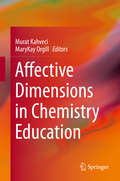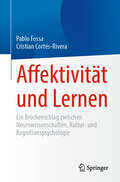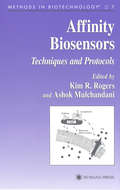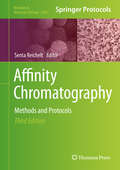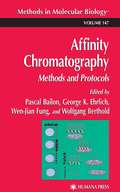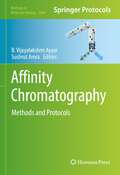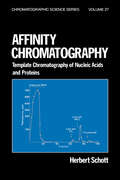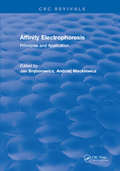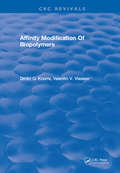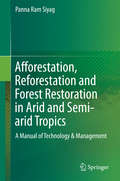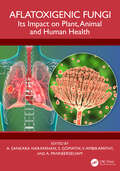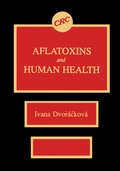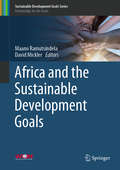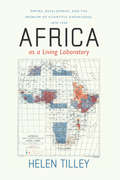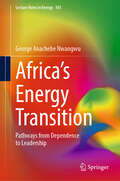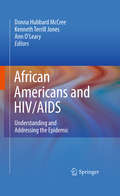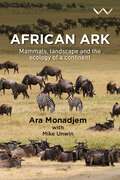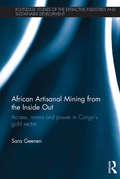- Table View
- List View
Affective Dimensions in Chemistry Education
by Murat Kahveci Marykay OrgillThis is a unique resource for those wishing to address the affective domain as they research and solve problems in chemistry education. Contributions by world-leading experts cover both fundamental considerations and practical case studies. This work fills a gap in the literature of chemistry education, which so far has focussed mainly on the cognitive domain. The affective domain refers to feelings-based constructs such as attitudes, values, beliefs, opinions, emotions, interests, motivation, and a degree of acceptance or rejection. It can affect students' interest in science topics and their motivation to persevere in learning science concepts.
Affective Injustice in Healthcare (The International Library of Bioethics #112)
by Brenda BogaertThis book explores the ambiguous role of affects in healthcare work and medical education. At the same time that healthcare professionals are often encouraged to suppress or downplay their affects in order to maintain a sense of professionalism, those of patients are frequently misunderstood or unheard - both within clinical settings and beyond. We argue that these are examples of affective injustice, instances in which emotional expression is dismissed as unprofessional, unproductive, or inappropriate in healthcare. We show that the suppression of affects is not only unrealistic but also potentially harmful, and how it can lead to burnout and dissatisfaction among healthcare providers as well as negatively affect care quality, in particular for marginalized groups. The ambition of the book is therefore to bring this controversial issue to the forefront and to demonstrate the value of affects in healthcare and medical education, as well as to offer several methodologies for greater affective expression and recognition in healthcare institutions.The first part of the book lays the theoretical groundwork, examining the relevance of the concept of affective injustice for healthcare, and the problems that affective injustice creates for care actors and for care quality. The second part offers some practical methodologies to move toward affective justice for patients and healthcare providers. Proposals include narrative methods, spiritual care, emotionally responsive hospital design and architecture, the possibilities and limits offered by patient research partners, and pedagogies for medical education. The book will end by showing how to take the framework forward, in particular through empirical bioethics research.This book will be of interest to scholars and educators in medical ethics, interdisciplinary researchers in the medical humanities, as well as patients, families, and healthcare providers interested in the role of affects in healthcare.
Affektivität und Lernen: Ein Brückenschlag zwischen Neurowissenschaften, Kultur- und Kognitionspsychologie
by Pablo Fossa Cristian Cortés-RiveraDieses Buch zeigt einen interdisziplinären Ansatz zur Untersuchung der Affektivität beim menschlichen Lernen und überbrückt dabei die Kluft zwischen Neurowissenschaften, Kultur- und Kognitionspsychologie. Es vereint Studien, die über den Fokus auf kognitiv-intellektuelle Variablen, die in Lernprozesse involviert sind, hinausgehen und die Untersuchung der Rolle von Affektivität und Emotionen beim Lernen nicht nur in Bildungssettings, sondern in allen Prozessen der Transformation und der menschlichen Entwicklung einbeziehen. Dazu wird Affektivität als Katalysator und Vermittler von täglichen Lernprozessen kritisch hinterfragt und im interkulturellen Diskurs betrachtet.Die Kapitel dieses Beitragswerkes präsentieren sowohl theoretische wie auch empirische Forschung aus verschiedenen Disziplinen wie Neurowissenschaften, kognitiver Psychologie, Kulturpsychologie, pädagogischer Psychologie, Entwicklungspsychologie und Philosophie und sind in fünf thematische Abschnitte gegliedert. Der erste Teil des Buches enthält Kapitel, in denen verschiedene Aspekte der Affektivität bei Lernprozessen aus der Sicht der Kultur-, Bildungs- und Entwicklungspsychologie erörtert werden. Der zweite Teil widmet sich der Affektivität in Bezug auf Lehrkräfte während ihrer Ausbildung und während ihrer pädagogischen Praxis in verschiedenen Kontexten. Der dritte Teil befasst sich mit der Beziehung zwischen Affektivität und Lernen aus neurowissenschaftlicher Sicht. Der vierte Teil befasst sich mit Affektivität und Lernen in therapeutischen und klinischen Kontexten. Der fünfte Teil fasst Kapitel über Affektivität und Lernen im Alltag zusammen.Durch die Zusammenstellung dieser reichhaltigen interdisziplinären Sammlung von Studien wird Affektivität und Lernen: Der Brückenschlag zwischen Neurowissenschaften, Kultur- und Kognitionspsychologie eine wertvolle Quelle für Forscher in den Bereichen Psychologie, Neurowissenschaften und Bildung sowie für Erzieher und Lehrer, diemehr über die Beziehung zwischen Affektivität und menschlichem Lernen erfahren möchten.Die Übersetzung wurde mit Hilfe von künstlicher Intelligenz durchgeführt. Eine anschließende menschliche Überarbeitung erfolgte vor allem in Bezug auf den Inhalt.
Affinity Biosensors: Techniques and Protocols (Methods in Biotechnology #7)
by Kim Rogers Ashok MulchandaniA cutting-edge collection of detailed, step-by-step techniques and protocols for constructing, evaluating, and using affinity-based biosensors. Ideal for novices starting research in their field or experienced researchers wanting to use a biosensor for a specific analytical measurement, the methods detailed here allow biochemists, analytical chemists, microbiologists, and engineers to successfully apply biosensor technology to their specific problems. The techniques include the use of antibodies and membrane receptors to construct optical, thermal, acoustic, and electrochemically based biosensors. Additional techniques involve antibodies, receptors, nucleic acids, liposomes, and eukaryotic cells. A companion volume, Enzyme and Microbial Biosensors: Protocols and Techniques, by Mulchandani & Rogers, concentrates on enzyme-biosensors.
Affinity Chromatography: Methods and Protocols (Methods in Molecular Biology #1286)
by Senta ReicheltThe aim of this edition is to introduce the beginner to the basics of affinity chromatography and provide practical knowledge for the development of affinity separation protocols. Affinity Chromatography: Methods and Protocols, Third Edition guides readers through new state of the art protocols, molecular modelling, and the study of ligand-target interactions. Written in the successful Methods in Molecular Biology series format, chapters include introductions to their respective topics, lists of the necessary materials and reagents, step-by-step, readily reproducible protocols, and notes on troubleshooting and avoiding known pitfalls. Authoritative and easily accessible, Affinity Chromatography: Methods and Protocols, Third Edition is designed as a useful resource for those interested in the rapid and quantitative isolation of biomolecules with high purity.
Affinity Chromatography: Methods and Protocols (Methods in Molecular Biology #147)
by Pascal BailonDetails powerful affinity chromatography methods, ranging from traditional affinity purification such as immunoaffinity chromatography, to the use of the latest phage-display technology in the discovery of affinity ligands and drugs. Also included are separations of small molecules such as haptens, protein ligands, and supramolecular structures. Each chapter is devoted to a specific technique and includes an introduction, an explanation of principles, a detailed materials list, and instructions. Practical notes suggest alternative procedures and describe how to overcome problems.
Affinity Chromatography: Methods and Protocols (Methods in Molecular Biology #2466)
by B. Vijayalakshmi Ayyar Sushrut AroraThis volume covers various aspects of affinity chromatography along with examples of its applications. Chapters guide readers through methodologies to purify a diverse array of molecular targets such as antibodies, extracellular vesicles, recombinant proteins, biomarkers, metabolites, plant organelles, nucleic acids, ligand identification and protocols on building affinity matrix. Written in the format of the highly successful Methods in Molecular Biology series, each chapter includes an introduction to the topic, lists necessary materials and reagents, includes tips on troubleshooting and known pitfalls, and step-by-step, readily reproducible protocols. Authoritative and cutting-edge, Affinity Chromatography: Methods and Protocols aims to be an invaluable resource to anyone employing affinity chromatography-based methodologies.
Affinity Chromatography: Methods and Protocols (Methods in Molecular Biology #421)
by Michael ZachariouThirty-eight years after its introduction, affinity chromatography remains a key tool in the armory of separation techniques available to separation and interaction scientists. Expanded and updated from the first edition, this second edition volume aims to provide the beginner with the practical knowledge needed to develop affinity separations suitable for a variety of applications relevant to the post-genomic era. It contains state-of-the-art, brand new protocols, and provides step-by-step laboratory instructions for readily reproducible results.
Affinity Chromatography: Template Chromatography of Nucleic Acids and Proteins
by Herbert SchottThis book informs the reader about the practical methods, possibilities, and limits of template chromatography. It shows the various techniques for immobilization of nucleic acids fragments, polynucleotides, and nucleic acids by which the desired separation of materials can be achieved.
Affinity Electrophoresis: Principles and Clinical Application
by Jan BreborowiczThis book discusses the topic of affinity electrophoresis (AFF-EP), which has become a useful tool for studies of biomolecular interactions. The book will discuss AFF-EP as an analytical method which has been used successfully for the diagnosis, differentiation, and monitoring of patients with various diseases. The book will also discuss other uses for the AFF-EP method.
Affinity Modification Of Biopolymers
by Dmitri G KnorreThe goal of this book is to give a systematic description of the main principles of affinity modification and applications, consideration of possibilities, and restrictions of the method. Modification within specific complexes is a special case of chemical modification which is widely used in the nonaddressed version in biochemistry and related areas. Therefore, we have included in the first introductory paper chapter of the book general considerations of chemical modifications of biopolymers and the application of biopolymers.
Affinity, That Elusive Dream: A Genealogy of the Chemical Revolution
by Mi Gyung KimMi Gyung Kim restores chemical affinity to its proper place in historiography and in Enlightenment public culture. The Chemical Revolution is usually associated with Antoine-Laurent Lavoisier, who introduced a modern nomenclature and a definitive text.
Afforestation, Reforestation and Forest Restoration in Arid and Semi-arid Tropics: A Manual of Technology & Management
by Panna Ram SiyagThe book is a comprehensive manual of practice for execution of afforestation and tree planting programmes in arid and semi-arid tropics. It includes a compact running account of the technology of afforestation and the relevant principles and practices in management of afforestation projects. It provides a wide range of structured information and a number of model designs which can be gainfully put to use by the field level supervisors as also by the managers concerned with planning and control of such projects. Written by a practising specialist, the book is invaluable for anyone concerned with the practice of afforestation and tree planting, be he a tree hobbyist or a school teacher, a professional forester or a senior policy maker in government, an industrialist or a philanthropist, an environmental activist or a member of a community service organization.
Aflatoxigenic Fungi: Its Impact on Plant, Animal and Human Health
by A. Panneerselvam A. Sankara Narayanan S. Gomathi V. AmbikapathyAflatoxigenic fungi, primarily belonging to the Aspergillus genus (A. flavus, A. parasiticus), are responsible for producing aflatoxins—highly toxic and carcinogenic secondary metabolites. These fungi pose significant risks to plant health, animal health, and human well-being due to their widespread contamination of food and feed. Aflatoxigenic fungi impact plants by causing diseases, and yield loss leads to economic loss and contamination. In connection with animals, aflatoxigenic fungi create toxicity in livestock, contamination of animal products, mortality, and economic loss. Finally, concerning humans, aflatoxigenic fungi lead to acute toxicity, carcinogenic effects, immune suppression, and nutritional risk.Features: Provides a systemic review of the recent developments in aflatoxigenic fungi on various biotic organisms Includes an overview of the impact of aflatoxins on various plants and on the agricultural economy Describes the role of aflatoxins in human health, including infants and in cancer Contains special emphasis on the control of aflatoxigenic fungi by nanomaterials and plant bioactive components Discusses the detection of aflatoxigenic fungi by surface-enhanced Raman spectroscopy (SERS)
Aflatoxins & Human Health
by Ivana DvorackovaThis up-to-date reference includes the most recent available data and detailed case studies concerning the potential health risks of aflatoxin in the human population. It covers everything from acute toxic effects of aflatoxin in men to original observations concerning occupational health hazards due to aflatoxin exposure via the respiratory tract.
Aflatoxins in Food: A Recent Perspective
by Khalid Rehman Hakeem Carlos A. F. Oliveira Amir IsmailMycotoxins are the metabolites of fungus and are reported to contaminate nearly 25% of the food produced worldwide. The mycotoxins of most significance are the aflatoxins due to their severe health implications and their prevalence in food commodities on a larger scale. Aflatoxins are produced by certain species of fungi the most prominent among which are Aspergillus flavus, A. parasiticus and A. nominous. Food commodities of African and South Asian countries are especially reported to have aflatoxins well beyond the allowable limits but due to the global trade of food commodities developed countries are also prone towards the perils of aflatoxins. Moreover, climate changes may have a substantial impact on the distribution and global prevalence of aflatoxins in the near future.The International Agency for Research on Cancer (IARC) has classified the aflatoxins as group 1 category carcinogen. Aflatoxins are also reported as teratogenic, mutagenic, growth retardant, immunosuppressant and may also cause nervous system and reproductive system disorders. Preventive approaches involving good manufacturing from “farm to fork” are the major focus of the current food industry.The aim of our book is to provide readers with the most recent data and up-to-date studies from aflatoxins research, with specific focuses on (i) the impact of aflatoxins on human health, (ii) new approaches by the researchers from different parts of the world to degrade aflatoxins and (iii) potential preventive approaches that can significantly lessen the burden of aflatoxins in food products
Africa and the Sustainable Development Goals (Sustainable Development Goals Series)
by Maano Ramutsindela David MicklerThe book draws upon the expertise and international research collaborations forged by the Worldwide Universities Network Global Africa Group to critically engage with the intersection, in theory and practice, of the Sustainable Development Goals (SDGs) and Africa’s development agendas and needs. Further, it argues that – and demonstrates how – the SDGs should be understood as an aspirational blueprint for development with multiple meanings that are situated in dynamic and contested terrains. As the SDGs have substantial implications for development policy and resourcing at both the macro and micro levels, their relevance is not only context-specific but should also be assessed in terms of the aspirations and needs of ordinary citizens across the continent. Drawing on analyses and evidence from both the natural and social sciences, the book demonstrates that progress towards the SDGs must meet demands for improving human well-being under diverse and challenging socio-economic, political and environmental conditions. Examples include those from the mining industry, public health, employment and the media. In closing, it highlights how international collaboration in the form of research networks can enhance the production of critical knowledge on and engagement with the SDGs in Africa.
Africa as a Living Laboratory: Empire, Development, and the Problem of Scientific Knowledge, 1870–1950
by Helen TilleyTropical Africa was one of the last regions of the world to experience formal European colonialism, a process that coincided with the advent of a range of new scientific specialties and research methods. Africa as a Living Laboratory is a far-reaching study of the thorny relationship between imperialism and the role of scientific expertise—environmental, medical, racial, and anthropological—in the colonization of British Africa. A key source for Helen Tilley’s analysis is the African Research Survey, a project undertaken in the 1930s to explore how modern science was being applied to African problems. This project both embraced and recommended an interdisciplinary approach to research on Africa that, Tilley argues, underscored the heterogeneity of African environments and the interrelations among the problems being studied. While the aim of British colonialists was unquestionably to transform and modernize Africa, their efforts, Tilley contends, were often unexpectedly subverted by scientific concerns with the local and vernacular. Meticulously researched and gracefully argued, Africa as a Living Laboratory transforms our understanding of imperial history, colonial development, and the role science played in both.
Africa's Energy Transition: Pathways from Dependence to Leadership (Lecture Notes in Energy #103)
by George Anachebe NwangwuThis book examines the critical challenges and opportunities surrounding climate change and the energy transition in Africa. While many Africans prioritize pressing concerns such as food scarcity, economic development, and unemployment, the book argues that the continent remains particularly vulnerable to climate-related impacts. Erratic weather patterns and extreme events exacerbate existing issues, including declining agricultural productivity, infrastructure damage, and political instability. Despite these challenges, the transition from fossil fuels to renewable energy presents significant economic opportunities for Africa. The book emphasizes that embracing this shift can help African countries transform their economies and strengthen resilience against climate change. It contends that the current international framework—where Africa has largely anchored its demands around climate justice—has yielded little tangible benefit for Africans. Instead, the book advocates for a shift in perspective: rather than focusing solely on historical emissions from the Global North, African nations should recognize the potential advantages of actively participating in the global energy economy. By seizing the opportunities inherent in this transition, African countries can reshape their economies and capitalize on emerging energy markets.
Africa's Path to Net-Zero: Exploring Scenarios for a Sustainable Energy Transition (CSR, Sustainability, Ethics & Governance)
by Shahbaz Khan Anil Kumar Sunil Luthra Samuel Chukwujindu Nwokolo Rubee SinghThis book provides a comprehensive analysis of the challenges and opportunities for achieving a net-zero energy transition in Africa. With a focus on policy, technology, financing, and socio-political factors, the book presents four potential scenarios for a sustainable energy transition in the continent. The scenarios presented highlight the importance of balancing economic growth with environmental sustainability and social development. While foreign investments in renewable energy could be beneficial, they must be carefully monitored and regulated to prevent exploitation and ensure accountability. The book also emphasizes the need for collaboration and a calculated transition to ensure that all stakeholders are involved in the process. Additionally, the challenges of achieving self-sufficiency and export-free energy are discussed, with the importance of setting limitations and regulations to prevent a vicious cycle of poverty and dependency on foreign aid. With a deep understanding of Africa's environmental, socio-political, and socio-cultural complexities, “Africa's Path to Net-Zero” offers valuable insights for policymakers, investors, and anyone interested in promoting a sustainable energy future for the continent.
Africa-EU Renewable Energy Research and Innovation Symposium 2018: 23–26 January 2018, National University of Lesotho On occasion of NULISTICE 2018 (Springer Proceedings in Energy)
by Moeketsi Mpholo Dirk Steuerwald Tonny KukeeraThis open access book presents the proceedings of the 2nd Africa-EU Renewable Energy Research and Innovation Symposium (RERIS 18), held in Maseru, Lesotho in January 2018. The symposium aimed to foster research cooperation on renewable energy between Africa and Europe – in academia, as well as the private and public sectors. Addressing thematic areas such as• Grid-connected renewable energy;• Decentralised renewable and household energy solutions;• Energy socioeconomics; and• Promotion of energy research, innovation, education and entrepreneurship,the book brings together contributions from academics and practitioners from the EU and Africa to enable mutual learning and knowledge transfer – a key factor in boosting sustainable development in the African renewable energy market. It also plays a significant role in promoting African renewable energy research, which helps to secure energy supply in both rural and urban areas and to increase generation capacities and energy system resilience. This book is an invaluable resource for academics and professionals across the renewable energy spectrum.
African American Girls: Reframing Perceptions and Changing Experiences (Advancing Responsible Adolescent Development)
by Faye Z. BelgraveThe teenage years can be exciting for girls, as they develop into young women and anticipate their future. For some, however, this developmental stage may be tempered by increased risks for teen pregnancy, school failure, and some health problems. African American Girls: Reframing Perceptions and Changing Experiences explores not only the challenges and stressors confronting this unique population, but also the strengths and resiliencies used to meet them. Examining prevailing trends while avoiding simplistic generalizations, the book is both descriptive (e.g., explaining similarities and differences with girls of other ethnicities and African-American boys in critical areas) and useful (e.g., providing concrete guidelines for professionals working to support prosocial development and prevent risky behaviors). This unique volume: addresses salient issues of self and identity, examines crucial domains, such as relationships, achievements and expectations, and issues that have a major impact on health and well-being, offers practical recommendations and resources for working with African-American girls during the period when life experiences and decisions are most likely to affect adult outcomes, discusses the lives of girls from diverse families, communities, and circumstances, explores the influences of family, peers, community, and cultural traditions, features sample activities for promoting positive development and includes quotations reflecting the perspectives of the girls in their own words. African American Girls is an essential resource for a wide range of professionals, including clinical, child, and school psychologists, counselors, therapists, and social workers. Whether one's specialty is prevention, intervention, education, or research, this book is a must-have volume.
African Americans and HIV/AIDS: Understanding and Addressing the Epidemic
by Ann O'Leary MPH Msw Kenneth Terrill Jones Donna Hubbard Mccree RphThe HIV/AIDS epidemic is burgeoning among African American men and women. Despite comprising only 13% of the population, 50% of new HIV diagnoses in 2004 were among African Americans. Among women and men who have sex with men (MSM), African Americans are grossly disproportionately affected by this epidemic, and this trend shows no sign of abating. This book seeks to explore some of the contextual factors that contribute to this disparity as well as ways to intervene to slow the growth of the epidemic in the U.S. This volume will focus on the history and context of HIV/AIDS in African Americans and interventions targeting specific sub-populations including adolescents, heterosexual men and women, men who have sex with men, incarcerated populations, and injection drug users. Context chapters will focus on specific contextual and structural issues related to HIV/AIDS transmission and prevention in African Americans including disparities in incarceration, racism, economic issues and substance abuse. Intervention chapters will focus on best-evidence and promising-evidence based interventions targeting HIV prevention in African Americans. These chapters will address the latest in intervention strategies, program evaluation, cost effectiveness and qualitative research methods and will include risk reduction, risk assessment, and testing and counseling.
African Ark: Mammals, landscape and the ecology of a continent
by Dr. Ara MonadjemThe story of how Africa’s mammals have helped shape the continent’s landscapes over time to support an amazing diversity of lifeAfrica is home to an amazing array of animals, including the world’s most diverse assortment of large mammals. These include the world’s largest terrestrial mammal, the African elephant, which still roams great swathes of the continent alongside a host of other well-known large mammals with hooves such as hippopotamuses, giraffes, rhinoceroses, and zebras. African Ark: Mammals, Landscape and the Ecology of a Continent tells the story of where these mammals have come from and how they have interacted to create the richly varied landscape that makes up Africa as we know it today. It gives an equal airing to small mammals, such as rodents and bats, which are often overlooked by both naturalists and zoologists in favor of their larger cousins. African Ark not only describes the diversity of African mammals and the habitats in which they live; it also explains the processes by which species and population groups are formed and how these fluctuate over time. A book on mammals would not be complete without attention placed on the impact of megafauna on the environment and the important roles they play in shaping the landscape. In this way, mammals such as elephants and rhinoceros support countless plant communities and the habitats of many smaller animals. The book brings in a human perspective as well as a conservation angle in its assessment of the interaction of African mammals with the people who live alongside them. African Ark is at once scientifically rigorous and accessible for the layperson and student alike, while drawing on the contributions of numerous zoologists, ecologists and conservationists dedicated to the understanding of Africa and its wildlife.
African Artisanal Mining from the Inside Out: Access, norms and power in Congo’s gold sector (Routledge Studies of the Extractive Industries and Sustainable Development)
by Sara GeenenArtisanal mining is commonly associated with violent conflict, rampant corruption and desperate poverty. Yet millions of people across Sub Sahara Africa depend on it. Many of them are living in eastern Democratic Republic of Congo (DRC), home to important mineral reserves, but also to a plethora of armed groups and massive human rights violations. African Artisanal Mining from the Inside Out provides a rich and in-depth analysis of the Congolese gold sector. Instead of portraying miners and traders as passive victims of economic forces, regional conflicts or disheartening national policies, it focuses on how they gain access to and benefit from gold. It shows a professional artisanal mining sector governed by a set of specific norms, offering ample opportunities for flexible employment and local livelihood support and being well-connected to the local economy and society. It argues for the viability of artisanal gold mining in the context of weak African states and in the transition towards a post-conflict and more industrialized economy. This book will be of great interest to researchers and postgraduates studying natural resources and development as well as those in development studies, African studies, sociology, political economy, political ecology, legal pluralism, and history.
